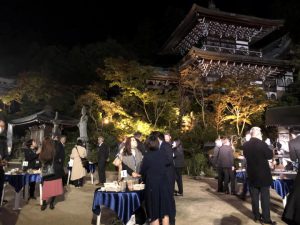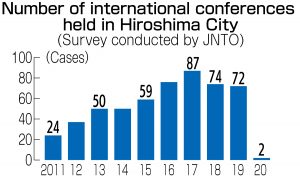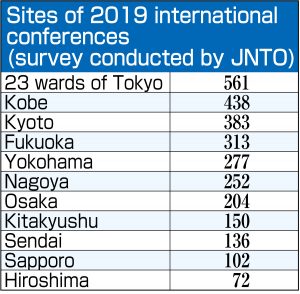Preparations for Hiroshima Summit 2023, Part 3: Attracting international conferences to area
Nov. 22, 2022
Chance to overcome long-standing issue
Collaboration among local communities key in promoting Hiroshima’s appeal
by Naoki Enomoto, Staff Writer
In contrast to its typical solemnity, the temple, with ties to the Buddhist priest Kukai (renowned historical figure and founder of one sect of Japanese Buddhism), had been completely transformed. On the evening of October 26, the gardens at Daisho-in Temple, located on Miyajima Island in Hatsukaichi City, were brilliantly illuminated and filled with around 50 people intent on enjoying performances featuring music and kendama, a traditional game using a ball and wooden cups that is a specialty product of the city, as well as cuisine cooked with local ingredients. In reality, hosted by the Hiroshima City government, the event was a simulation of a party designed to attract to the area meetings, incentives, conferences, and exhibitions (MICE), including international conferences. A video was made of the event that will be used to promote the unique experiences available on the island, which is a designated World Heritage site.
Only 72 cases in 2019
For Hiroshima City, attracting MICE events has been a challenge for many years. According to the Japan National Tourism Organization (JNTO), the number of MICE events held in Hiroshima totaled 72 in 2019, three years prior to the start of the coronavirus pandemic. That number was far below the 438 for Kobe City and the 313 for Fukuoka City, both of which, like Hiroshima, are government-designated cities that meet certain standards in terms of population and size. A variety of factors have been singled out as the cause of the variance between Hiroshima and the other cities, including lack of conference halls and hotels able to accommodate large numbers of people, as well as the great distances needed to travel between such venues and the Hiroshima Airport in Mihara City or the Hiroshima University campus in Higashihiroshima City.
As a result of collaborative efforts between the public and private sectors, however, the city successfully was able to attract to Hiroshima the summit meeting of the G7 (attended by the Group of Seven industrialized nations), to be held in May 2023. Koji Ikeda, chairperson of the Hiroshima Prefectural Chamber of Commerce and Industry who will serve as vice chair of the Hiroshima Summit prefectural council, expects that hosting the G7 Hiroshima Summit will provide evidence that Hiroshima is indeed a city with potential for hosting world-class international conferences, which could be of help in luring MICE events to Hiroshima.
In recent years, so-called “unique venues” such as cultural assets and tourism facilities that can provide visitors with special experiences have been utilized for MICE events. Examples of such venues are Nijo Castle and Toei Kyoto Uzumasa Park, in Kyoto. Hiroshima City has designated 20 sites as unique venues in Hiroshima Prefecture, including Daisho-in Temple, as well as Hiroshima Castle and the Hiroshima Museum of Art (both located in the city’s Naka Ward), and in neighboring Yamaguchi Prefecture’s Iwakuni City. The G7 Hiroshima Summit will provide a favorable tailwind for promoting the attractiveness of such sites.
Aki Matsumoto, head of Hiroshima City’s MICE strategy division, understands the importance of determining ways in which the upcoming G7 summit meeting can be used to promote and enhance Hiroshima’s appeal. In October this year, Hilton Hiroshima, a hotel in the city’s Naka Ward with large-capacity halls, opened its doors for business. The hotel will serve as another favorable advantage for attracting MICE events.
From 2 to 17 cases
Amid intense competition among cities, a staff member at the international strategy division of the Mie Prefecture government, which hosted the Ise-Shima Summit in May 2016, said, “The summit meeting certainly raised our name recognition.” The number of MICE events held in the prefecture rose to 17 in 2016 from only two in 2014. In Shima City, the location of that summit’s main venue, a resort hotel was opened in March 2016. In April that year, the prefectural government made numerous related efforts, including the appointment of a division manager-level MICE event promotion supervisor.
Next year, 2023, the G7 Transport Ministers’ Meeting will be held in Shima City. Nevertheless, an analysis conducted by the city’s international strategy division discovered little interest in such summit meetings outside of the participating countries, particularly in Asia. That result points to the importance of MICE marketing strategies that are not reliant on summit meetings.
International conferences can take several years from consideration of a host site to final selection of a location, with support for the organizers of the events indispensable. Toshinori Saito, associate professor at the Seisa University Graduate School and a member of the Information Processing Society of Japan (based in Tokyo) who served as head of the steering committee for an international conference held in Hiroshima City in August 2022, recalled the decisive factor in the selection of Hiroshima to host the summit. He cited as the reason being the overwhelming support received from Hiroshima University, local governments, tourism-related organizations, and others, in addition to the city’s past experience in holding a variety of such conferences.
How should Hiroshima move forward with an eye on the post-summit period? Mitsuru Moriguchi, managing director of MICE Japan, located in Tokyo, and an expert on strategies for marketing MICE events, advised that unique attractions only possible in Hiroshima are essential in that marketing effort and emphasized the importance of people in the local communities taking advantage of the opportunity presented by the summit and enhancing their collaboration.
(Originally published on November 22, 2022)










